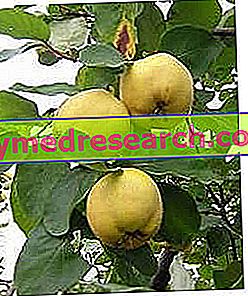Curiosity
They speak of her as a forgotten fruit: the quince, which boasts a literally legendary past, unfortunately suffers a far less interesting present. Legend has it that the quince represented the emblem of Venus, a symbol of good luck and fruitfulness in marriage banquets at the time of the Gods.

Quince: generalities
In botanical terms, the quince is Cydonia oblonga or Amygdalus persica, belonging to the Rosaceae family (subfamily of the Pomoidae). The quince is a sort of hybrid of pears and apples: not surprisingly, the varieties of fruits characterized by an apple shape are called meli quinces, vice versa, the elongated characteristic gives the fruit the term of quince pear.
The quince is native to the Caucasus and Asia Minor areas, and is still widespread in countries bordering the Western Mediterranean and China.
Currently, in Italy it is a not very renowned fruit: production has undergone a drastic contraction since the 1960s.
The tree reaches heights generally between 4 and 6 meters, and it is cultivated mainly for fruits, quinces, in fact: the fruits - which are actually false fruits - are called pomi and have variable dimensions with an asymmetrical shape. Particular is the hair that surrounds the pericarp: the thick hair disappears when the fruit has reached maturity.
Quince seeds, often numerous, have a polygonal shape and are piled up, almost glued, by a mucilaginous film that unites them.
The pulp, compact and firm, is astringent and acidulous: strictly speaking, the fruit is rarely eaten fresh. However, the meat of the fruit is very rich in pectins, which makes the quince particularly suitable for the preparation of jams and as a thickener.
The flowers, skilfully raised from the plant at the beginning of spring, are white and pink, and have 5 petals. The leaves, on the other hand, are simple, alternate and covered with a velvety thin layer of hair.
The quince plant is well suited to poor soils: the tree requires only good drainage and does not like very calcareous soils.
Food uses
As we have seen, the fresh consumption of quince has been supplanted by that of sweeter and juicy apples ( Malus communis ). Precisely due to the strongly astringent and acidulous characteristics of the pulp, the quinces are exploited mostly in the kitchen as a thickener of jams, thanks to the richness in pectins: as Tradition teaches, in respect of ancient preservation techniques, the quince is still exploited also for the preparation of mustards, liqueurs, spirits in general and jellies. La Cotognata is a special jelly based on quince, typical of the town of Codogno (Lodi).
The leaves cannot be eaten because - as we will see - they contain toxic substances.
Flavor of the quince
The sour and slightly sweet taste of the quince does not depend on the absence of sugars, but rather on the presence of the same in the form of long chains. With the heat treatment - therefore through the cooking of quince - the long glucidic chains are fragmented, therefore the mass assumes a sweeter and more intense taste, releasing a pleasant smell, very similar to honey.
Quince marmalade
X Problems with video playback? Reload from YouTube Go to Video Page Go to Video Recipes Section Watch the video on youtubeQuince: nutritional properties
Quinces only supply 26 Kcal per 100 grams of product, equivalent to 108 Kjoules;

Quinces are a source of vitamins (especially A, C, B1 and B2) and mineral salts, including potassium, phosphorus, sulfur, calcium and magnesium.
Therapeutic properties
If, on the one hand, the quince is marginalized in the kitchen, in phytotherapy its importance is still appreciable.
Previously we saw that the dried leaves of the quince apple are toxic, due to the presence of amygdalin; however, in the past, the decoction of dried leaves was exploited for its anthelmintic properties.
For the positive functionality at the gastro-intestinal level, the quince is considered a panacea for all purposes: in fact it boasts tonic, astringent and anti-inflammatory properties of the digestive system.
The tannins contained in the quince are able to protect the mucosa of the intestine.
The quince, like all apples, contains organic acids, including malic acid, which helps digestion.
Consumed cooked, the quince has a strong laxative property, stimulating and promoting intestinal motility thanks to the generous presence of fibers and pectins.
In cosmetics, the quince is used for seeds that, as we have seen, are agglomerated thanks to a mucilaginous layer that unites them: the mucilages exert an appreciable protective activity against dehydration of the skin, in addition to counteracting the onset of wrinkles.
Moreover, it seems that the quince is a good natural remedy against cough and sore throat (in the form of decoction or maceration) and lack of appetite.
Quince apples in brief »



